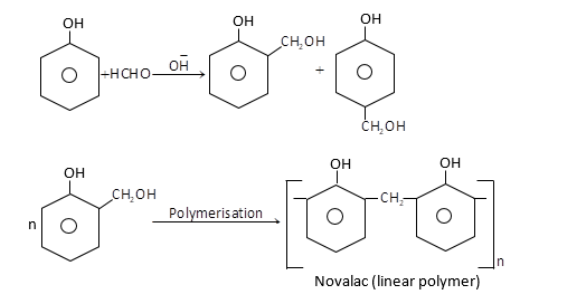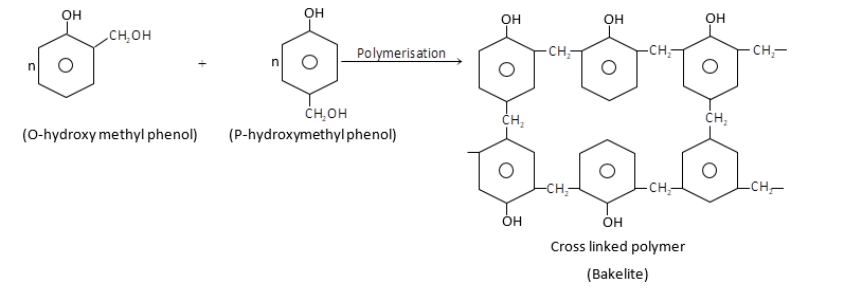
Write the name of monomers used for getting the following polymers:
(i) Bakelite (ii) Neoprene.
Answer
219k+ views
Hint: Polymers are the materials made up of long, repeating chains of molecules. The polymers have unique properties, depending on the type of monomers being used for the formation of polymers.
Complete step by step solution:
(i) Bakelite: It is a copolymer made up of phenol and formaldehyde. Phenol – Formaldehyde resins are obtained by the reaction of phenol and formaldehyde in the presence of a basic catalyst. The reaction involves the formation of methylene bridges in ortho, para or both ortho and para positions of phenol. When the polymerisation of these substituted phenols take place, result into the formation of a linear polymer called Novalac which is used in paints. The reaction for this polymerisation is given below,

Novalac on heating with $HCHO$undergo cross linkage to form an infusible solid called bakelite.

$\therefore $Monomers of bakelite are phenol and formaldehyde
(ii) Neoprene: Its monomer chloroprene is prepared from acetylene
\[\mathop {2CH \equiv CH}\limits_{acetylene} \mathop {\xrightarrow[{N{H_4}Cl}]{{C{u_2}C{l_2}}}}\limits_{\left( {343K} \right)} \mathop {{H_2}C = CH - C \equiv CH}\limits_{\left( {vinylacetylene} \right)} \xrightarrow{{HCl}}\mathop {{H_2}C = CH - C \equiv C{H_2}}\limits_{\left( {Chloroprene} \right)} \]
Chloroprene undergoes free radical polymerization to form neoprene. It polymerizes very rapidly and the reaction occurs by $1,{\text{ 4}}$- addition of one chloroprene to another.
Note: Neoprene was the first synthetic rubber manufactured on a large scale. It is also called diprene. The properties of neoprene are similar to natural rubber but neoprene is more resistant to action of oils, gasoline and other hydrocarbons. It is non – inflammable. Bakelite is used for making combs, fountain pens, electrical goods, etc. Soft Bakelite with low degree of polymerisation are used as binding glue for laminated, wooden plants and lacquers. Sulphonated bakelites are used as ion exchange resins.
Complete step by step solution:
(i) Bakelite: It is a copolymer made up of phenol and formaldehyde. Phenol – Formaldehyde resins are obtained by the reaction of phenol and formaldehyde in the presence of a basic catalyst. The reaction involves the formation of methylene bridges in ortho, para or both ortho and para positions of phenol. When the polymerisation of these substituted phenols take place, result into the formation of a linear polymer called Novalac which is used in paints. The reaction for this polymerisation is given below,

Novalac on heating with $HCHO$undergo cross linkage to form an infusible solid called bakelite.

$\therefore $Monomers of bakelite are phenol and formaldehyde
(ii) Neoprene: Its monomer chloroprene is prepared from acetylene
\[\mathop {2CH \equiv CH}\limits_{acetylene} \mathop {\xrightarrow[{N{H_4}Cl}]{{C{u_2}C{l_2}}}}\limits_{\left( {343K} \right)} \mathop {{H_2}C = CH - C \equiv CH}\limits_{\left( {vinylacetylene} \right)} \xrightarrow{{HCl}}\mathop {{H_2}C = CH - C \equiv C{H_2}}\limits_{\left( {Chloroprene} \right)} \]
Chloroprene undergoes free radical polymerization to form neoprene. It polymerizes very rapidly and the reaction occurs by $1,{\text{ 4}}$- addition of one chloroprene to another.
Note: Neoprene was the first synthetic rubber manufactured on a large scale. It is also called diprene. The properties of neoprene are similar to natural rubber but neoprene is more resistant to action of oils, gasoline and other hydrocarbons. It is non – inflammable. Bakelite is used for making combs, fountain pens, electrical goods, etc. Soft Bakelite with low degree of polymerisation are used as binding glue for laminated, wooden plants and lacquers. Sulphonated bakelites are used as ion exchange resins.
Recently Updated Pages
Is PPh3 a strong ligand class 12 chemistry JEE_Main

Full name of DDT is A 111trichloro22bispchlorophenyl class 12 chemistry JEE_Main

Sodium acetate on heating with soda lime produce A class 12 chemistry JEE_Main

Find the isoelectric point pI of Lysine A 556 B 974 class 12 chemistry JEE_Main

The order of basicity among the following compounds class 12 chemistry JEE_Main

The number of isomers in C4H10O are a7 b8 c6 d5 class 12 chemistry JEE_Main

Trending doubts
JEE Main 2026: Application Form Open, Exam Dates, Syllabus, Eligibility & Question Papers

Derivation of Equation of Trajectory Explained for Students

Hybridisation in Chemistry – Concept, Types & Applications

Understanding the Angle of Deviation in a Prism

Understanding Collisions: Types and Examples for Students

Understanding Atomic Structure for Beginners

Other Pages
NCERT Solutions For Class 12 Chemistry Chapter 1 Solutions - 2025-26

NCERT Solutions for Class 12 Chemistry Chapter Chapter 7 Alcohol Phenol and Ether

NCERT Solutions ForClass 12 Chemistry Chapter Chapter 8 Aldehydes Ketones And Carboxylic Acids

JEE Advanced Marks vs Ranks 2025: Understanding Category-wise Qualifying Marks and Previous Year Cut-offs

Haloalkanes and Haloarenes Class 12 Chemistry Chapter 6 CBSE Notes - 2025-26

Solutions Class 12 Chemistry Chapter 1 CBSE Notes - 2025-26




